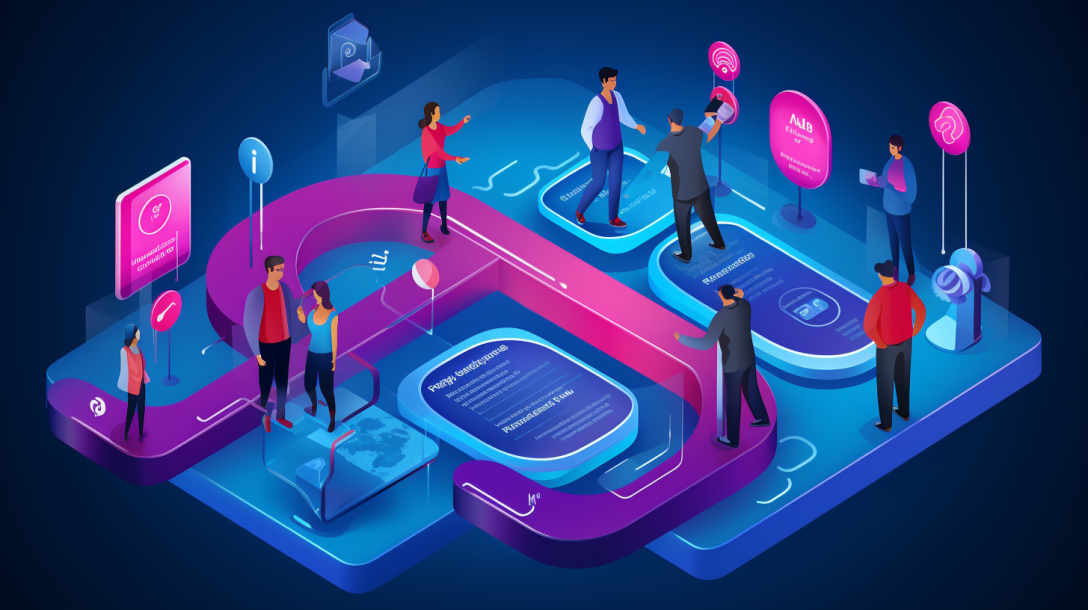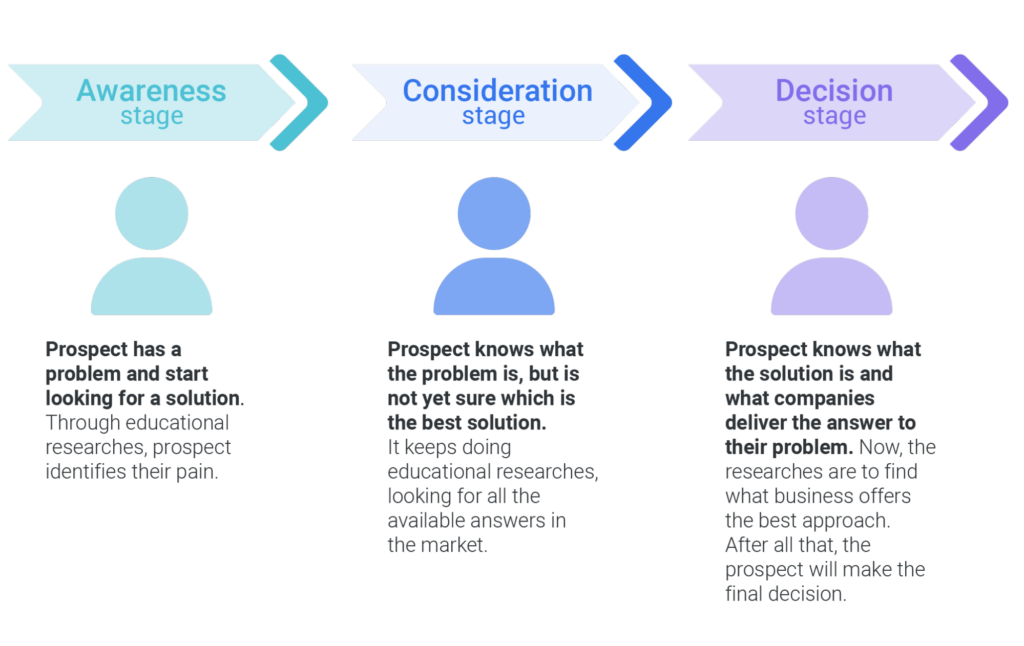The 6 Essential Steps to Every Buyer Journey Mapping

If there’s one thing we know for sure about B2B buyers, it’s that they rarely make an on-the-spot decision. Instead, they search Google to weigh their options, where they might come across your business in the process–or they might not.
During their journey, B2B buyers don’t want surprises and confusion. 80% appreciate content that helps them learn about a product or service during their research stage. This explains why B2B marketing is about providing the right content and information at the right time.
82% of B2B marketers already use content marketing to move buyers towards the purchase stage, but how do they know what qualifies as the “right” content at the “right” time? Without providing an expert voice when they need it most, you could fall short of their expectations, miss out on lead generation opportunities, and fail to offer solutions to their problems.
The solution to these problems is buyer journey mapping, an essential strategy for B2B marketing. It helps you create the ideal purchase experience and puts you in the buyer’s shoes, so you can better understand what they want to know and when they want to know it.
This post will look at the B2B buyer journey, why mapping it is so important, and reveal the six essential steps to mapping every buyer journey.
What is the B2B Buyer Journey?
The buyer journey represents the path your prospects follow before making a purchase. Where B2C buyer journeys focus on simply making a sale, B2B marketing requires active cultivation of leads to appeal to industry-specific and customized pain points.
A typical B2B buyer goes through three stages:

1. Awareness
The path to purchase begins when the buyer realizes they have a problem that needs solving. Sometimes buyers aren’t certain what their problem is, which is an opportunity for brands to help them explore their issues and needs.
2. Consideration
During the consideration stage, buyers research and evaluate multiple options on the market to decide which one will be the best solution for them.
3. Decision
At this point, the buyer has concluded their search, made a choice, and completed a purchase. But your work doesn’t end here – the buyer becomes a customer, and the retention process begins.
On the surface, the journey through these three stages seems simple. However, the reality is much more complex. To efficiently produce sales, this journey requires a map.
What is Buyer Journey Mapping, and why is it so important?
B2B buying often involves multiple stakeholders, budget restrictions, and goals. The stakeholders’ roles will also change depending on the industry, vertical, and company. For this reason, B2B purchasing decisions take time, which can be months or even years.

Mapping buyer journeys allows you to zoom out from the details and complexity of B2B buying and create a simple, effective path to purchase. You can leverage real-time data to deliver personalized experiences and interactions throughout the buyer journey, which stops your buyers from feeling like you’re wasting their time.
Personalization is becoming the norm in B2B marketing. 80% of buyers are more likely to purchase when brands offer an experience tailored to them. It can also be beneficial to your bottom line, with 80% of companies seeing an improvement in sales after implementing personalized communications. But without mapping your buyer journey first, you won’t know what information to deliver and when.
Content: The Key to Buyer Journey Mapping
On their buyer journey, prospects will be searching for answers and information in various kinds of content on different platforms. What they are looking for depends on what stage of the buyer journey they are at.
For each stage, these particular forms of content are most effective:
Awareness
- Blogs
- Google rankings
- Social media posts
- Online ads
Consideration
- Long-form videos
- Checklists
- Whitepapers
Decision
- Competitor comparisons
- Loyalty programs
- Pricing pages
After mapping your buyer journey, you can plan and create content that strategically answers decision-makers’ questions at each stage and aids their discovery process. For example, 73% of B2B marketers agree that blog posts are effective awareness-stage content for lead generation. Blogs are a popular way for brands to deliver the “three Es” to prospective buyers–education, entertainment, and expertise.
If we jump to the end of the buyer journey, blog posts don’t have the same impact. Why? Because buyers at the decision stage have already gathered the necessary information. Now, they’re looking for a concrete reason to choose your business over your competitors.
Although blog posts might not work as well later down the line, 40% of marketers agree that case studies are a powerful decision-stage content marketing tool to help solidify stakeholders’ buying choices. A great case study contains statistics and proof points to show exactly how your solution helped solve another client’s problem. It should answer and finalize any last-minute queries to seal the deal.

The 6 Essential Steps to Every Buyer Journey Mapping
As B2B buyers invest more time and resources into researching their purchases, their buyer journey needs to ensure that all roads lead to your business. Follow this framework to map the buyer journey successfully.
1. Create your buyer personas
It’s impossible to create the proper content for an “anonymous persona” effectively. This makes it essential to ask the big question: who is your target audience? To effectively communicate with B2B prospects, you need to think like them, which starts with defining buyer personas.
A buyer persona is a character that personifies the data you’ve collected about your target audience and ideal buyer. It includes insights into the industry, vertical, company size, job title, and demographics. But the best buyer personas dig a lot deeper, as we’ll explore in the next section.
2. What problems do your buyers have?
Now that you’ve defined your ideal buyer and their role in the decision-making process, it’s time to get deeper into their head. The next step is to consider your buyers’ problems and what information they will need to help them solve these issues.
Keyword research is a great place to begin uncovering what B2B buyers are searching for. 59% of buyers prefer to clarify their needs and possible solutions themselves before engaging with sales reps, usually through internet searches. Showing you understand their problems is your big shot at offering expertise and knowledge so your brand sticks in the buyer’s mind.
3. How can you present solutions?
Now you know what problems your buyers are facing. How can your business offer a solution? Buyers will hit your solution-based content at the consideration stage, meaning it’s a good idea to research how your competitors use content marketing to promote their capabilities and USPs.
Although buyers are unlikely to compare you with your competitors until the decision-making stage, weighing your solutions against the competition can help ensure that your consideration-stage content provides the information buyers are looking for.
4. Define your touchpoints

Before creating your marketing content, you must plan when and how you will interact with your buyers. Some B2B marketers suggest that it takes seven touchpoints to turn a prospect into a customer, which would function as a guide if the B2B buyer journey was linear.
Unfortunately, it’s not. B2B buyers jump forwards, backward, and stay stagnant all at once. This almost quantum-level shopping activity is why every touchpoint on your buyer journey should play a role in supporting prospects’ needs, answering their questions, and pushing them to the next stage.
Analytics tools can help identify keywords, content formats, and topics buyers are most likely to interact with. Along with the touchpoints in the previous section, an effective strategy is creating content to fill in the gaps so you are continually offering insightful resources.
5. Map Your Content Strategy
Content marketing can come in many forms, like podcasts, whitepapers, and case studies. Mapping your content strategy over your buyer journey helps you ensure that your content addresses the buyer’s challenges, goals, and level of interest at each stage.
If every buyer asks your sales team the same question during the decision stage, why not create a video that provides the answer? If your landing page hits are low, you could link it in lead generation emails sent to buyers at the consideration stage.

A recent study discovered that 73% of B2B buyers now expect a personalized B2C-style experience. It’s a tough ask for your content marketing team, considering that 62% of purchases involve more than four people. One solution is introducing a journey orchestration platform like TrenDemon, which automatically serves every website visitor with personalized content at each journey stage.
6. Test Drive Your Buyer Journey
77% of B2B buyers say their last purchase was very complex and challenging, which is a surefire way to send your prospects running to the competition.
What you hope your buyers are experiencing during their journey might not be accurate. Ensure you’ve created a smooth buyer journey by road-testing it yourself or asking a colleague or friend to try it out. You can also use analytics tools to tweak your touchpoints and strategy according to what’s working.
Optimizing the Buyer Journey with Trendemon
B2B buying is a complex and lengthy process that is far from predictable. Mapping the buyer journey is your best bet at understanding your target audience’s problems and how they might seek out your business and competitors as a solution. Your content marketing strategy goes hand-in-hand with the buyer journey at every stage, giving them the information they need in the right format at the right time.
Trendemon accelerates the buyer journey by automatically defining your audiences and creating recommended content, CTAs, and tailored offers. It takes the strain off your marketing team by helping convert anonymous website visitors into engaged leads through personalization, so you can build strong buyer relationships and prevent prospects from slipping through the cracks.
Request a Trendemon demo today to see how you can convert more visitors and accounts into sales opportunities.